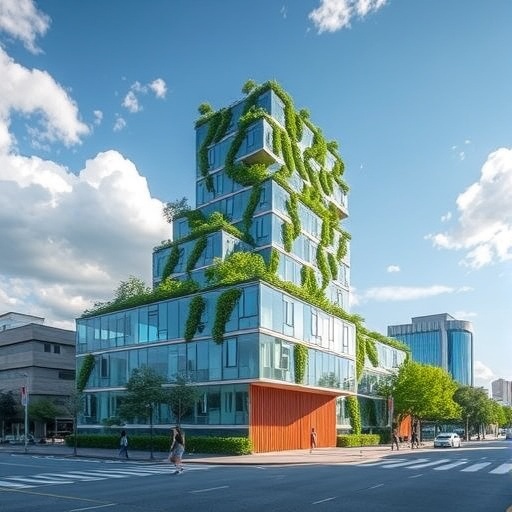A recent study highlights the pivotal role of architectural innovation in mitigating climate change, especially within urban residential contexts. The research, conducted by Yuan, Hadafi, and Nik, presents a comprehensive qualitative analysis of how design strategies can be adapted globally to reduce carbon emissions and enhance sustainability in cities. The collective insights from this study reveal the necessity of synergizing architectural practices with environmental considerations, paving the way for a more sustainable future.
The urban landscape is an intricate tapestry of structures that define our daily lives. This study emphasizes that these very structures can either exacerbate or alleviate the ongoing climate crisis. The authors argue for the integration of eco-friendly materials and designs that minimize the ecological footprint of residential buildings. By harnessing local resources and promoting green architectures such as vertical gardens and green roofs, urban planners and architects can significantly contribute to climate resiliency.
Furthermore, the research delves into the importance of adaptive architectural changes informed by climate data. The researchers assert that understanding local weather patterns and geographical nuances enables architects to create buildings that are not only energy-efficient but also capable of withstanding the impacts of climate change. For instance, regions susceptible to flooding can benefit from elevated designs that protect homes while maintaining aesthetic value. This kind of forward-thinking architecture is essential for fostering sustainable urban environments.
The qualitative approach adopted in the study offers a rich narrative, drawing attention to case studies across various urban settings worldwide. The findings highlight a mosaic of successful architectural strategies, including the use of sustainable materials, energy-efficient systems, and innovative design techniques that can be replicated in different cultural contexts. This cross-pollination of ideas creates a vibrant discourse on sustainability, where local adaptations can lead to global impacts.
In addition, the study confronts the often-overlooked relationship between residents and their architectural surroundings. It suggests that sustainable design should not just be about materials and techniques, but also about human experience and community involvement. Engaging residents in the design process fosters a sense of ownership and responsibility towards their environment. This not only promotes better maintenance of these eco-friendly structures but also encourages a broader cultural shift towards sustainability.
A significant part of the research focuses on the role of policies and regulations in shaping sustainable architectural practices. The authors argue that governmental frameworks must incentivize sustainable construction practices while also reflecting the urgency of the climate crisis. This requires collaborative efforts among architects, policymakers, and community stakeholders to establish guidelines that prioritize long-term ecological health over short-term economic gains.
The findings of the study paint a hopeful picture, illustrating that architectural innovation can be a robust tool in the fight against climate change. The collective action of architects and urban planners based on the study’s insights can lead to substantial reductions in urban carbon footprints. By reimagining urban residential spaces as sites of environmental synergy, it becomes possible to foster sustainable lifestyles that benefit both individuals and the planet.
Emerging trends in sustainable architecture, such as biophilic design and smart technologies, are also explored in-depth within the research. By marrying natural elements with digital advancements, architects can create dynamic living environments that not only adapt to climate challenges but also enhance the well-being of residents. The integration of smart energy systems, for instance, allows for real-time energy management, ultimately reducing waste while promoting efficient resource use.
What stands out is the emphasis on social equity within the sustainable architecture discourse. The research advocates for strategies that are accessible and beneficial for all demographic segments, ensuring that the benefits of sustainable living are not limited to affluent communities. Inclusive urban redevelopment that prioritizes diverse voices will lead to more equitable cities, addressing the disparities that often exacerbate the effects of climate change.
As urban populations continue to swell, the urgency for innovative architectural solutions becomes ever more pressing. The study underscores that the responsibility lies not just with architects but with entire communities to advocate for sustainable practices. Educational initiatives aimed at raising awareness about the importance of sustainable architecture can galvanize public support and action, driving a cultural shift towards eco-conscious living.
In conclusion, Yuan, Hadafi, and Nik’s research presents a comprehensive outlook on the architectural contributions to climate change mitigation. Their findings serve as a clarion call for architects, urban planners, and policymakers to collaborate and innovate for a sustainable future. The intersections of design, human experience, and environmental stewardship outline a pathway towards cities that thrive in harmony with nature rather than in opposition to it.
In a world where climate change is an impending threat, this research encapsulates the essence of hope and possibility. The architectural community possesses the unique potential to redefine urban living, making it synonymous with sustainability. Indeed, as the saying goes, “the strength of the future lies in our structures today.”
As the authors conclude, the path to a resilient urban future will be determined by the ingenuity of contemporary architecture, proactive policies, and the collective commitment of society to embrace a more sustainable lifestyle.
Subject of Research: Architectural contributions to climate change mitigation in urban residential contexts through a global qualitative approach.
Article Title: Architectural contributions to climate change mitigation in urban residential contexts through a global qualitative approach.
Article References:
Yuan, J., Hadafi, F., Nik, A.S. et al. Architectural contributions to climate change mitigation in urban residential contexts through a global qualitative approach.
Discov Sustain 6, 1002 (2025). https://doi.org/10.1007/s43621-025-01791-9
Image Credits: AI Generated
DOI: 10.1007/s43621-025-01791-9
Keywords: Architectural innovation, climate change mitigation, sustainable architecture, urban residential, qualitative approach, eco-friendly materials, energy efficiency, community involvement, policy frameworks, social equity.




